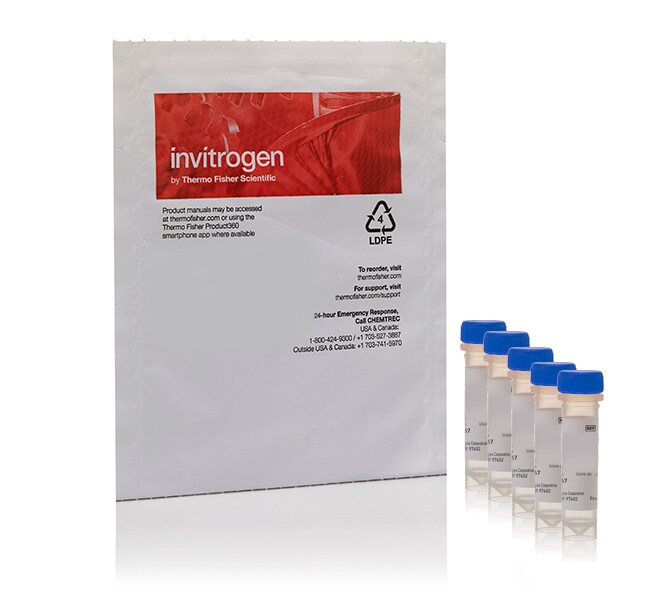Search Thermo Fisher Scientific

CellTracker™ Fluorescent Probes
| Catalog Number | Quantity | Dye Type |
|---|---|---|
| C10094 | 5 x 0.1 mg | CellTracker Violet BMQC |
| C2110 | 5 mg | CellTracker™ Blue CMAC |
| C2111 | 5 mg | CellTracker™ Blue CMHC |
| C12881 | 5 mg | CellTracker Blue CMF2HC |
| C34565 | 20 x 15 μg | CellTracker™ Deep Red |
| C7025 | 20 x 50 μg | CellTracker Green CMFDA |
| C2925 | 1 mg | CellTracker Green CMFDA |
| C2102 | 5 mg | CellTracker Green BODIPY |
| C34551 | 20 x 50 μg | CellTracker Orange CMRA |
| C2927 | 1 mg | CellTracker Orange CMTMR |
| C34552 | 20 x 50 μg | CellTracker™ Red CMTPX |
Features of the CellTracker dyes include:
- Easy to use—remove culture media, add dye, incubate 15-45 minutes, and image cells
- Excellent retention—fluorescent signal retention of >72 hours (typically three to six generations)
- Ideal tracking dyes—monitor cell movement, location, proliferation, migration, chemotaxis, and invasion
- Low cytotoxicity—does not affect viability or proliferation
- Cell Versatility– works with cells in suspension and adherent cells
The CellTracker fluorescent probes have been designed to freely pass through cell membranes; however, once inside the cell are transformed into cell-impermeant reaction products. The CellTracker fluorescence probes (except for CellTracker Deep Red) contain a chloromethyl or bromomethyl group that reacts with thiol groups, utilizing a glutathione S-transferase–mediated reaction. In most cells, glutathione levels are high (up to 10 mM) and glutathione transferase is ubiquitous. CellTracker Deep Red probe contains a succinimidyl ester reactive group, which reacts with amine groups present on proteins.
After conversion to impermeant versions, the CellTracker fluorescent probes are well retained in living cells through several generations. The probes are transferred to daughter cells, but are not transferred to adjacent cells in a population. Cells loaded with the CellTracker fluorescent probes display fluorescence for at least 72 hours and exhibit ideal tracking dye properties—they are stable, nontoxic at working concentrations, well retained in cells, and brightly fluorescent at physiological pH. Additionally, several CellTracker fluorescent probes with various excitation and emission spectra are available allowing for multiplexing in fluorescence imaging. The CellTracker dyes are retained with fixation and permeabilization, enabling their use with antibodies for fluorescence immunostaining applications.
Spectral characteristics of the fluorescent CellTracker probes:
- CellTracker Blue CMAC—353/466 nm
- CellTracker Blue CMF2HC—371/464 nm
- CellTracker Blue CMHC—372/470 nm
- CellTracker Violet BMQC—415/516 nm
- CellTracker Green CMFDA—492/517 nm
- CellTracker Green BODIPY™—522/529 nm
- CellTracker Orange CMTMR—541/565 nm
- CellTracker Orange CMR—548/576 nm
- CellTracker Red CMTPX—577/602 nm
- CellTracker Deep Red—630/660 nm
Fluorescent CellTracker reagents include the blue-fluorescent chloromethyl derivatives of amino-, hydroxy-, and difluorohydroxycoumarin (CMAC, CMHC and CMF2HC), the green-fluorescent chloromethyl derivatives of fluorescein diacetate (CMFDA) and a BODIPY™ dye, the orange-fluorescent CMTMR and CMRA, and the red-fluorescent CMTPX. CellTracker Blue CMAC, CMHC, and CMF2HC, CellTracker Violet, the violet-fluorescent bromomethyl derivative of coumarin (BMQC), CellTracker Green BODIPY™, CellTracker Orange CMTMR, and CellTracker Red CMTPX do not require enzymatic cleavage to activate their fluorescence, whereas the green CMFDA and orange CMRA do require enzymatic cleavage. The impermeable reaction products of the chloromethyl or bromomethyl coumarins have excellent retention, strong fluorescence, and relatively uniform cytoplasmic staining, making these derivatives potentially useful for correcting motion artifacts in imaging. CMFDA is colorless and non-fluorescent until cytosolic esterases cleave off the acetates, releasing a brightly fluorescent product.
In addition to bright fluorescence and excellent retention, the CellTracker fluorescent probes do not contribute to cytotoxicity.
Store at ≤-20°C, protect material from long-term exposure to light; may be exposed to light for short periods of time.


